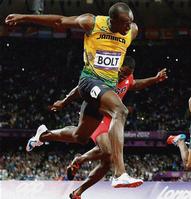


Jamaica's Usain Bolt (left) crosses the finish line ahead of United States' Justin Gatlin (partly hidden). (Right) Shelly-Ann Fraser-Pryce - File
Researchers have proposed that a key component to blistering Jamaican speed may have to do with having well-balanced knees.
Jamaican sprinters have dominated the global stage over the last couple of years, perhaps best epitomised by the world's fastest man Usain Bolt, but with sprinters such as Yohan Blake, Shelly-Ann Fraser-Pryce and Asafa Powell also making their mark.
Scientists believe a long-term research project, which began in 1996, producing findings related to the body symmetry of Jamaican children could prove helpful in explaining the phenomena.
Findings showed that the most symmetrical children with the most symmetrical knees, who took part in the study, were the most likely in the group to become the best sprinters when they became adults.
"We found that Jamaican children have particularly symmetric legs, in comparison to Europeans. Furthermore, in children symmetry in the legs, particularly in the knees, predicted their willingness to sprint and their sprinting times when they were adults,"
Professor John Manning of Northumbria University in Newcastle told UK publication The Independent.
body symmetry
The project involved about 300 primary school children, with an average age of eight when the study started. They were measured for body symmetry at the start of the project and have been followed up over the years with a series of further tests.
The researchers returned to the island to re-measure the children and to test such attributes as handedness, doll-cradling tendencies, aggression, religious convictions, and now sprinting speed. Of the 288 children who took part in the project, 163 volunteered to undertake sprinting tests in 2010 when they were in their early twenties.
"With regard to sprinting, we found that participants with symmetric legs in 1996, particularly knees, tended to volunteer for the sprints and they tended to run the fastest when tested in 2010. Also, there was some evidence that these Jamaican children had substantially more symmetry in their legs than UK children," he said.
"So we think our results inform the debate as to why Jamaicans tend to win gold medals in sprinting. I think this may, in part, explain Jamaican success in sprinting disciplines".
